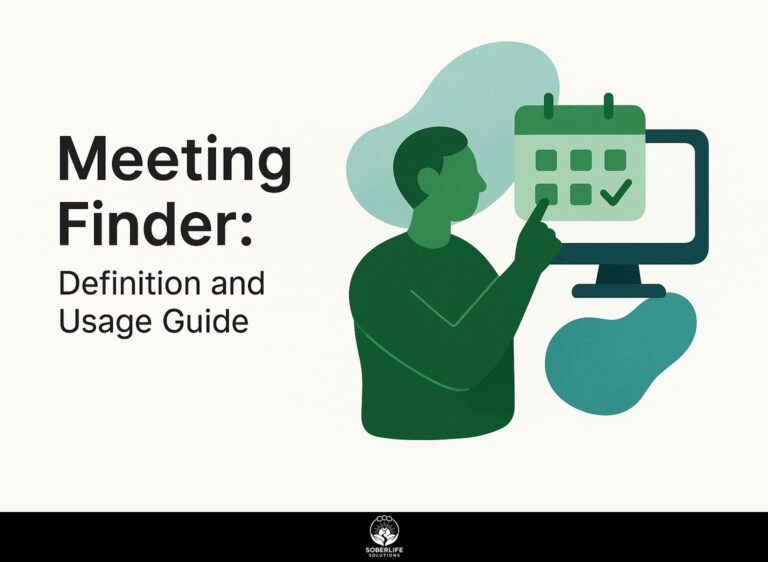Temperature Checks in A.A. Meetings: Importance and Guidelines
In Alcoholics Anonymous and Narcotics Anonymous 12-step meetings, temperature checks are important for maintaining group behavior and creating a welcoming environment. Expert Theresa Parisi highlights their role in promoting open communication and making sure members feel secure. This article will discuss the importance of temperature checks, offer key guidelines for how to use them, and share best practices to help facilitators avoid side conversations while managing group interactions.
Key Takeaways:
- Temperature checks in A.A. meetings create a safe space where people can share their feelings, building trust and support among members.
- Frequent temperature checks promote honest conversations, making sure everyone feels heard and appreciated, which is important for team unity.
- Facilitators should implement temperature checks consistently and respond constructively to feedback, creating a supportive atmosphere that addresses members’ needs.
Definition and Purpose
A temperature check is a fast way to see how participants feel and think at the start or end of a meeting.
You can do these checks using easy methods. For example, use a round-robin approach where each person takes a turn to say a word or phrase that reflects their current feelings.
Use online tools like Mentimeter or Slido to gather anonymous feedback with polls. This invites people to join in and makes it easier for everyone to share their opinions.
Conclude the meeting by revisiting these feelings to assess any shifts, enhancing team cohesion and communication.
Historical Context in A.A.
Temperature checks have been used in Alcoholics Anonymous meetings for many years, changing from basic verbal questions to more organized formats.
These checks now change based on whether meetings are in-person or virtual.
In traditional in-person meetings, participants can take turns sharing how they feel. In online meetings, tools like Zoom let people use reactions, such as thumbs up or down, to easily show their emotions.
Some groups use written surveys to collect anonymous feedback, which helps them understand how people feel. This method demonstrates AA’s commitment to upholding traditions while using modern technology, ensuring that every member feels recognized and supported.
Importance of Temperature Checks
Temperature checks are important for creating a safe space where people can share their feelings and communicate openly, a principle that is crucial for effective group dynamics as discussed in a recent article by Asana. Additionally, understanding the impacts of physical health on group interactions, such as the effects of dehydration, is vital; you might find useful strategies in our article on [Dehydration Symptoms and Hydration Tips](https://soberlifesolutions.com/dehydration-symptoms-hydration-tips/).
Fostering a Safe Environment
By regularly implementing temperature checks, groups can create a safe environment where members feel comfortable sharing without fear of judgment.
To organize these checks well, begin meetings by asking, “On a scale of 1 to 10, how excited do you feel about today’s agenda?” This method measures energy levels and encourages conversation. Additionally, understanding the benefits of peer support groups can enhance these discussions.
You can use anonymous polls to understand people’s feelings, which helps them respond honestly without the fear of being recognized. Using these methods regularly builds respect and encourages more involvement, improving how the group works together.
Encouraging Open Communication
Encouraging open communication through temperature checks allows members to articulate their feelings, leading to more productive discussions.
By integrating temperature checks into regular meetings, you create a safe space for honest feedback. According to research published by Taylor & Francis, such practices can enhance group dynamics significantly.
For instance, employ tools like Slido or Google Forms to anonymously gather sentiments before discussions begin. Pose questions such as, “How comfortable do you feel voicing your concerns?” or “What issues need more attention?”
After gathering responses, set aside time in the meeting to discuss these concerns openly. This approach builds trust within the group, as members recognize that their opinions are respected and taken seriously.
Guidelines for Performing Temperature Checks 1. Use a reliable thermometer to measure the temperature. 2. Clean the thermometer before and after each use. 3. Follow the manufacturer’s instructions for the thermometer. 4. Take the temperature in a consistent location (oral, rectal, or underarm). 5. Record the temperature immediately after checking. 6. If the temperature is higher than normal, follow up with a healthcare professional.
To carry out proper temperature checks, there should be clear rules on how often to do them and the methods to use to keep participants involved and the process meaningful. As highlighted in a Qualtrics guide on survey methodology and compliance best practices, establishing these guidelines is essential for effective participant engagement.
Frequency and Timing
Check the temperature of the group at the start and end of meetings to understand changes in emotions.
Starting the meeting with a quick pulse check-perhaps using a simple thumbs-up or down-helps gauge participants’ initial feelings. Consider using tools like Mentimeter or Slido for anonymous feedback.
Finish by bringing this idea back, and ask participants to rate their experience or share any shifts in their views. This promotes openness and encourages genuine discussion.
To get the best results, set aside 5 minutes for each temperature check. This can increase participation and give helpful information.
Methods of Implementation
Implement temperature checks through various methods, such as verbal check-ins, anonymous surveys, or digital platforms like Zoom polls.
A good way to check the temperature of the team is by using anonymous surveys on Google Forms. This lets team members express their opinions freely, creating a safe space for sharing.
Pairing this with virtual options like Zoom, where participants can use the polling feature, offers real-time feedback during meetings.
For in-person settings, consider using mood boards or simple thumbs-up/thumbs-down signals to gauge feelings quickly.
Using these tools gives you more ways to engage people and encourages them to share their feelings openly.
Best Practices for Facilitators
Facilitators play a key role in building a positive space for temperature checks, ensuring that everyone’s views are heard and appreciated. This approach mirrors the principles seen in As Bill Sees It Meetings, where inclusivity and understanding are foundational.
Creating a Supportive Atmosphere
Creating a supportive atmosphere involves setting ground rules for sharing and ensuring that all participants feel valued and respected.
Facilitators can use specific techniques to improve this setting. Begin by setting clear rules, like asking everyone to share their ideas without interruptions. This promotes open discussion.
Model empathetic listening by summarizing participants’ points before responding, showing that their input is valued. Regular check-ins can also be beneficial; ask participants how they feel about the discussions and if adjustments are needed.
This regular feedback process creates trust and respect, ensuring that everyone feels safe and heard throughout the experience.
Responding to Feedback
Effective facilitators listen to feedback from temperature checks by changing meeting formats and addressing concerns quickly.
If people think meetings are too lengthy, establish a time limit for each topic. A Timer app on smartphones can help keep conversations on track.
If feedback shows a preference for more hands-on sessions, using break-out groups can increase participation. Zoom has breakout rooms that allow for smaller discussions.
By regularly reviewing feedback and adjusting accordingly, facilitators can create a more responsive and effective meeting environment, leading to improved collaboration and productivity.
Challenges and Solutions
Temperature checks are helpful, but facilitators often encounter issues like pushback from members or the need to keep information private. Understanding different support structures, such as those described in As Bill Sees It Meetings: Definition and Benefits, can provide valuable insights into managing these challenges.
Addressing Resistance
Resistance to temperature checks can stem from fear of vulnerability; addressing it requires patience and empathy from facilitators.
To manage resistance well, facilitators should create a safe space by promoting open conversation and maintaining confidentiality. For instance, begin meetings with icebreaker activities to build trust.
Next, use positive reinforcement; acknowledge participants’ feelings and contributions, which helps reduce anxiety. Employ techniques like active listening and reflective questioning, allowing team members to voice their concerns and feel understood.
Tools like anonymous surveys can reveal the concerns of participants, allowing for direct attention to specific problems.
Maintaining Confidentiality
Ensuring confidentiality during temperature checks is essential for building trust among members, encouraging open sharing.
To maintain confidentiality, implement anonymous feedback methods such as online surveys or suggestion boxes.
Tools like SurveyMonkey allow users to provide input without revealing their identities. Emphasize the importance of privacy by regularly communicating your commitment to confidentiality-this can be done through team meetings or newsletters.
Set specific rules for using feedback and make sure that any information gathered is combined to protect individual identities, creating a safer space for open discussions.
Frequently Asked Questions
What are temperature checks in A.A. meetings and why are they important?
Temperature checks in A.A. meetings are quick ways to see how attendees feel about the meeting and their recovery process. They matter because they create a welcoming space, promote sharing, and help recognize if anyone is having a hard time or needs help, which strengthens the group.
How can temperature checks improve the experience during A.A. meetings?
Temperature checks can enhance A.A. meetings by giving members an easy way to share their feelings and thoughts. This practice can help foster empathy and strengthen relationships among participants, leading to a more supportive environment that supports recovery.
What rules should be followed when taking temperature checks during A.A. meetings?
When checking in on feelings during A.A. meetings, it’s essential to make sure that members feel safe to share their thoughts. Some guidelines are to promote honesty without criticism, keep comments short, allow everyone a chance to speak, and respect those who might not want to share.
How frequently should temperature checks happen during A.A. meetings?
Temperature checks in A.A. meetings can happen at the start, middle, or end of the meeting, based on what the group prefers. Doing these checks regularly, like every week or every other week, can help everyone stay aware of the group’s feelings and needs.
Can we use temperature checks for online A.A. meetings?
Yes, temperature checks can be modified for online A.A. meetings by using tools like polls, chat options, or by asking members to unmute and express their feelings. Changing temperature checks for a virtual setting helps keep connections strong and provides support, even when members are not in the same place.
What are the benefits of implementing temperature checks in A.A. meetings?
Bringing temperature checks into A.A. meetings can improve communication, encourage more members to join in, spot problems early, and build a stronger community. These actions can help group interactions and support each person’s recovery.






